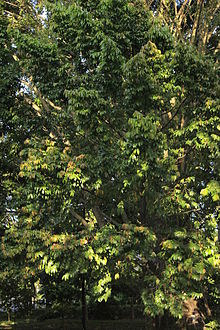| This article needs additional citations for verification. Please help improve this article by adding citations to reliable sources. Unsourced material may be challenged and removed. Find sources: "Diospyros celebica" – news · newspapers · books · scholar · JSTOR (July 2012) (Learn how and when to remove this message) |
| Diospyros celebica | |
|---|---|

| |
| Conservation status | |
 Vulnerable (IUCN 2.3) | |
| Scientific classification | |
| Kingdom: | Plantae |
| Clade: | Tracheophytes |
| Clade: | Angiosperms |
| Clade: | Eudicots |
| Clade: | Asterids |
| Order: | Ericales |
| Family: | Ebenaceae |
| Genus: | Diospyros |
| Species: | D. celebica |
| Binomial name | |
| Diospyros celebica Bakh. | |
Diospyros celebica (commonly known as black ebony or Makassar ebony) is a species of flowering tree in the family Ebenaceae that is endemic to the island of Sulawesi in Indonesia. The common name Makassar ebony is for the main seaport on the island, Makassar.
Description
The tree grows up to 20 m (66 ft) high under favourable circumstances, although such trees are rarely seen nowadays.

The heartwood of D. celebica shows a wide striped pattern of dark brown and the typical black of ebony wood. As macassar ebony, it has been traded since the colonial period and is regarded as a valuable wood for a variety of woodworking.
Distribution
D. celebica is endemic to Sulawesi. It has been extensively logged for its wood since colonial times and its current conservation status is considered "vulnerable".
Uses
The wood of D. celebica is the source of the variegated ebony variety macassar ebony. The wood is often defective, showing cracks, and in particular heart shakes and splits. It is not easy to dry and is best given ample time for this. Converting logs into boards as soon as possible is recommended.
It is considered a highly valuable wood for turnery, fine cabinet work, and joinery. It is also used as a wood in fingerboards for guitars and other related instruments. Japan used to be the main importer of this wood and is much sought for posts (床柱 (tokobashira)) in traditional Japanese houses.
References
- ^ World Conservation Monitoring Centre (1998). "Diospyros celebica". IUCN Red List of Threatened Species. 1998: e.T33203A9765120. doi:10.2305/IUCN.UK.1998.RLTS.T33203A9765120.en. Retrieved 19 November 2021.
- ^ "Diospyros celebica". Germplasm Resources Information Network. Agricultural Research Service, United States Department of Agriculture. Retrieved June 17, 2017.
- "Search Key: とこばしら". WWWJDIC. Retrieved June 17, 2017.
External links
- [REDACTED] Media related to Diospyros celebica at Wikimedia Commons